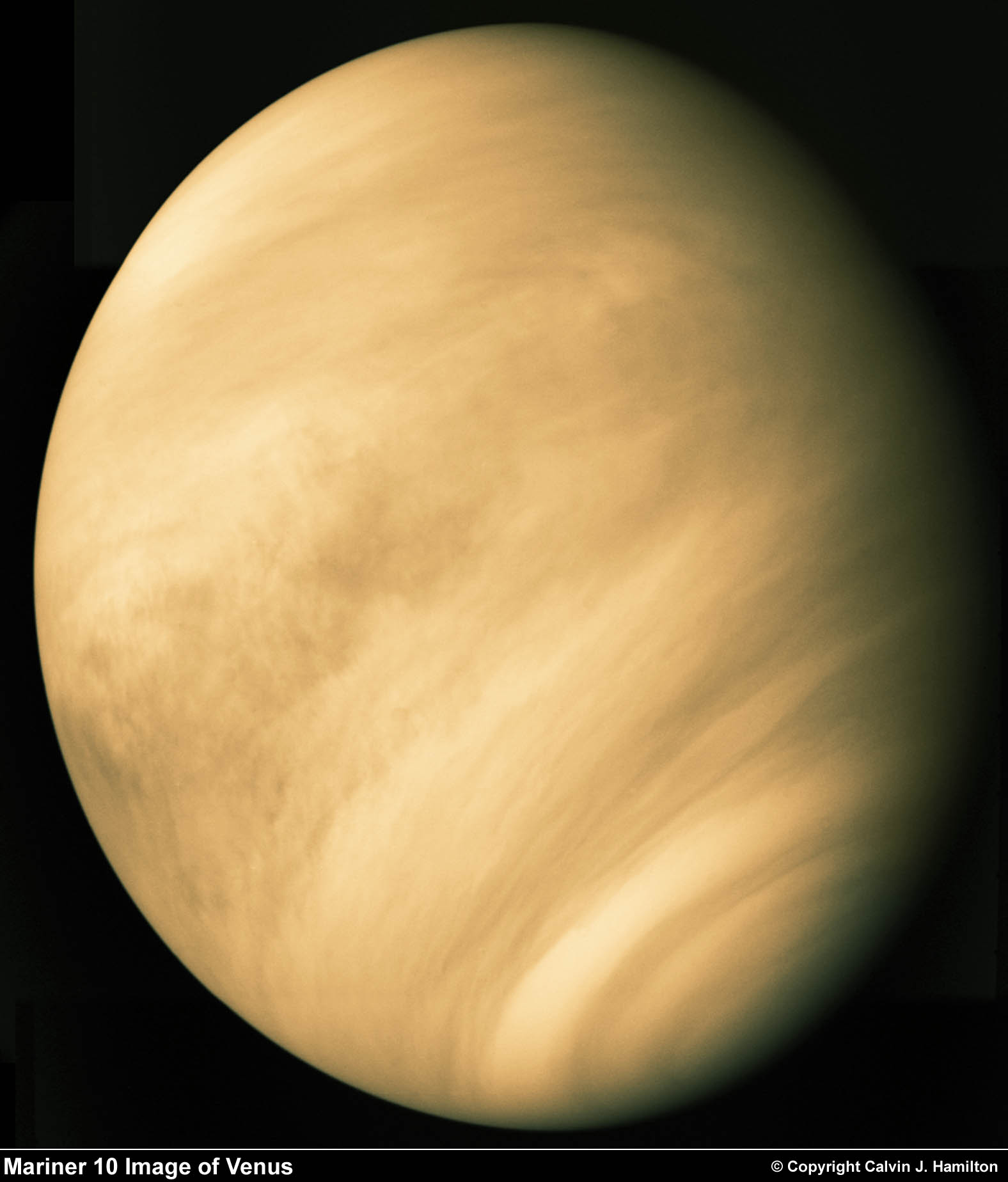 |
(to left, courtesy NASA, from Solar Views, http://www.solarviews.com/raw/venus/venusmar.jpg., above, Shukra, the planet Venus, divine sage and tutor of the demons. Here he is riding a rabbit. from The Black Peacock, http://www.goloka.com/index.html) |
Key points: Conditions on Venus; runaway greenhouse; greenhouse and global warming on Earth
 |
(to left, courtesy NASA, from Solar Views, http://www.solarviews.com/raw/venus/venusmar.jpg., above, Shukra, the planet Venus, divine sage and tutor of the demons. Here he is riding a rabbit. from The Black Peacock, http://www.goloka.com/index.html) |
Superficially very like Earth:
similar mass, diameter, interior structure, not too different in distance from the sun
Rotation synchronized with -- the earth! A "day" is 243 Earth days.
Although now we know better, Venus has not been completely ignored in imagining
life elsewhere - and beautiful life at that![]()
The Magellan mission mapped the surface of Venus by using radar, which penetrated the Venusian clouds to reveal a variety of surface features including:
Impact Craters (NASA/JPL, Magellan Project)
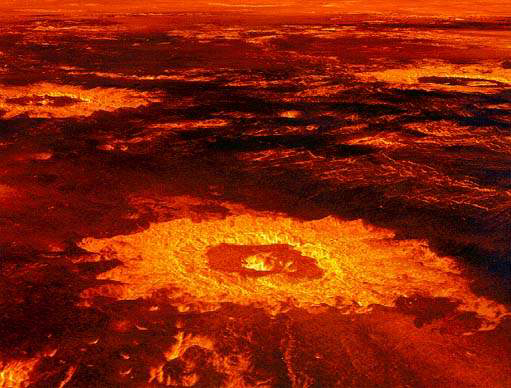
Volcanic domes (NASA/JPL, Magellan Project)
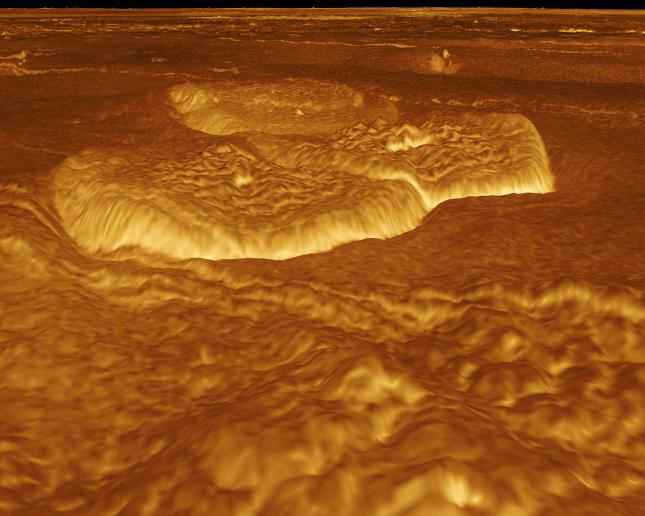
Volcanoes and lava flows.(From Magellan Project and D. H. Grinspoon, http://www.funkyscience.net/)
 |
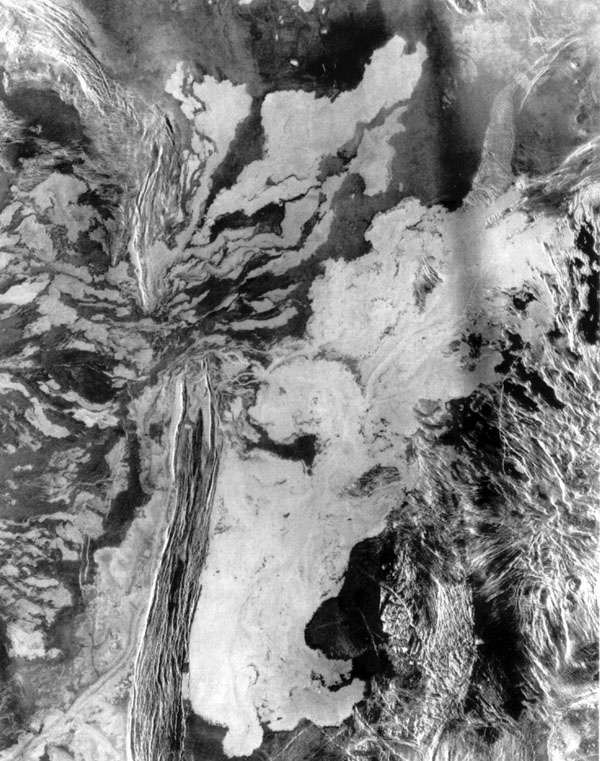 |
For an imaginary airplane flight over these
features, check this animation: (warning: large file
(6 MB)) ![]() However, the animation
shows only the rocky terrain, no lava or clouds because they were not detected by the
Magellan radar. The flight might actually look more like this artist's conception that
includes volcanic steam, clouds and mist, and lava flows (warning, large file (4MB))
However, the animation
shows only the rocky terrain, no lava or clouds because they were not detected by the
Magellan radar. The flight might actually look more like this artist's conception that
includes volcanic steam, clouds and mist, and lava flows (warning, large file (4MB))![]() (both animations from Calvin J.
Hamilton, http://www.solarviews.com/eng/venus.htm)
(both animations from Calvin J.
Hamilton, http://www.solarviews.com/eng/venus.htm)
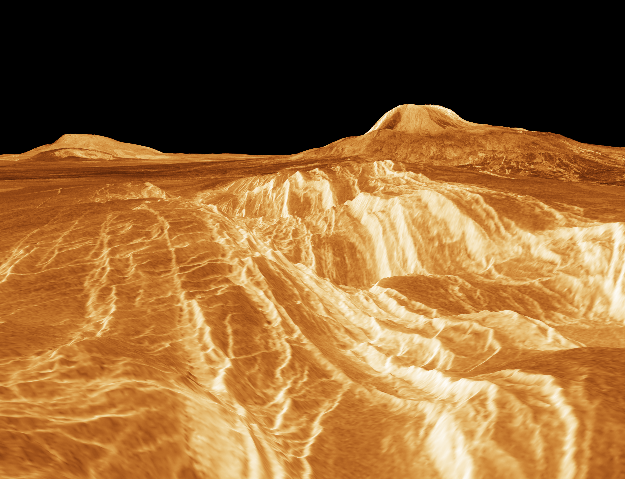 |
This is what the surface would look like if we landed and climbed a hill to look around. (From the Magellan Project, JPL/NASA, http://antwrp.gsfc.nasa.gov/apod/ap960624.html) |
In fact, Russian missions have landed on Venus revealing the bare, rocky surface:
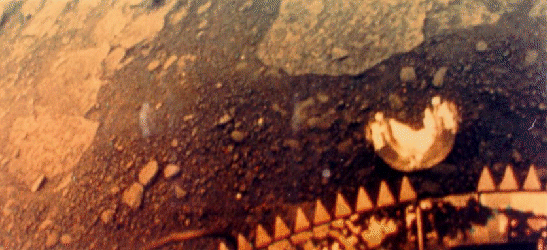 Venera 14 spacecraft to right, a picture of the surface above (from Soviet Planetary Exploration Program via Astronomy Picture of the Day, http://antwrp.gsfc.nasa.gov/apod/ap990124.html |
 |
| Finally, here is the stark Venus landscape
from Venera 13, reworked to enhance the more distant view. Don Mitchell, Photoshop News, http://photoshopnews.com/2006/09/12/old-soviet-images-of-venus-yield-fresh-surprises/ |
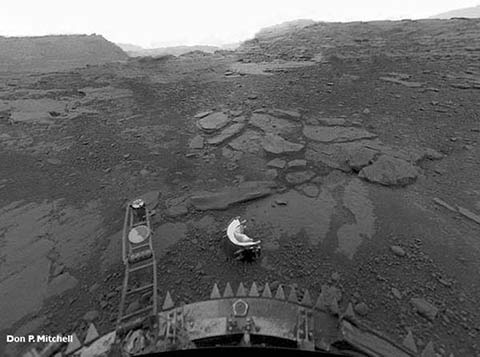 |
The Atmosphere
The atmosphere is 96.5% CO2 and with virtually no water (very different from Earth).
The surface pressure is about 90 times higher than on Earth. At this pressure, CO2 is highly absorbing both at 15 microns and near 5 microns = 5000nm. With a surface temperature of about 730K, by Wien's law the emission peak is close to 5000 nm.

where
![]() is the wavelength of
the maximum emission (in nm)
is the wavelength of
the maximum emission (in nm)
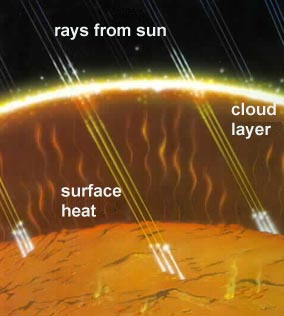 |
The sunlight is mostly at wavelength of~ 0.6
microns = 600nm, which is not absorbed efficiently in CO2 , so
the sunlight scatters its way through the clouds and eventually makes it to the surface.
It warms the surface and the surface then radiates in the infrared. However, the CO2
absorbs the infrared radiation and it does not all escape into space, but much of it is
trapped between the surface and the CO2 layers in the atmosphere. The end
result is that the surface heats to 730K - only at this high temperature is it possible
for the energy to escape at the same rate it is absorbed by the surface. By Wien's Law, at
this temperature much of the energy is shorter than the CO2 absorption at 4000
to 5000 nm, so it can escape and stop further heating of the surface. (From Germantown Elementary School, http://www.germantown.k12.il.us/html/Venus.html) This process makes the atmosphere incredibly hot and maintains the high surface temperature. |
Any water originally on Venus has boiled into the atmosphere and been broken apart by ultraviolet light from the sun. The hydrogen has escaped so water cannot form again. Venus has lost almost all water.
Water is key in controlling the greenhouse effect on Earth: (1) the oceans absorb a lot of CO2 (2) water and CO2 react with silicate rock to lock the CO2 up in carbonaceous rock; and (3) water nourishes plants, which remove CO2 from the atmosphere. When Venus lost its water, it was no longer able to suppress atmospheric CO2 and was doomed to develop an extreme greenhouse effect.
Global warming has obviously occurred on Venus - how can we apply what we have learned there to the critical issue of our own planet? First, we have to be very careful in our approach, because the issue has become very political and the logic is sometimes misunderstood or even stretched to make a point. We suggest approaching the question in the following four steps. It is important not to mix them, although that is done all the time out in the real world. We have already seen with Galileo how dangerous this combination can be.
1. Is global warming occurring? (the answer should be based on pure observational science and we can hope to determine it reliably)
2. What is causing it? (this answer is still in the realm of science but is more complex because we can't do experiments to test our theories in a controlled way, but have to rely on interpretation of observations of a very complex process - weather)
3. Is it a threat to us? (now we start to mix uncertain science - taking our theories of the causes of global warming and projecting them into the future - with politics - who is 'us', what is our threshold to declare something to be a 'threat' as opposed to something less serious)
4. What should we do about it? (we have progressed into almost pure politics with this question, and because of the complexities in question 3 it is politics on a shaky foundation -- however, this is of course the crucial question)
Let's see how far we can get with question 1, is global warming occurring?:
| The graph to the right shows three independent sets of determinations of the global temperatures (relative to an average set to zero). A long-term warming trend started shortly after 1900, but with lots of short term fluctuations and even a significant leveling-off from 1940 to 1975 and perhaps another short leveling starting in 2000. Three independent studies (and others not shown) agree closely (NOAA, the National Oceanic and Atmospheric Administration; NASA, the National Aeronautics and Space Administration; MET Office Hadley Centre/Climatic Research Unit). The net effect is just under a degree Celsius. (From"Responding to Climate Change," http://www.rtcc.org/)
|
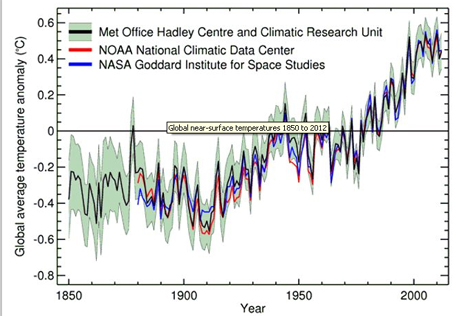 |
There are also many indirect measures, although they are harder to interpret quantitatively. For example, the Arctic ice cap is shrinking very rapidly, and there is also significant shrinkage in the Antarctic. The direct temperature measurements are clear that a modest but significant warming has occurred over the past century.
How about question 2: What is causing this trend?
We will return to this question in a future chapter. There, we will show that a number of factors may be contributing. However, based on our discussion of Venus, here we discuss in detail one of them, the greenhouse effect.
 |
Carbon dioxide (and water)
have absorptions near 7 and 15 microns that produce a greenhouse effect that warms the earth to a comfortable
temperature for life as we know it. The difference
from Venus is that carbon dioxide is only 0.03% of the atmosphere of the earth, whereas it
is 96.5% of the atmosphere of Venus. This picture shows how it works. Sunlight is either absorbed or reflected by the surface of the earth. The absorbed part heats the surface, and causes it to emit where the 15 micron greenhouse effect operates. Thus, some portion of the energy is trapped and warms the surface above the temperature for a planet without an atmosphere.From UCAR Communications, http://www.ucar.edu/communications/newsreleases/2001/learnweb.html |
 |
There is an increase by 20% in the last 40 years! The CO2 concentration is now higher than at any time in the past millions of years. (From the National Oceanographic and Atmospheric Administration (NOAA) http://www.esrl.noaa.gov/gmd/ccgg/trends/) Since we humans are making this extra carbon dioxide, it seems likely that we have had an influence - and/or will have an influence - on the global temperature. We will identify additional factors at work in a future chapter. |
We all agree so far -- but what will happen next? Will the increased CO2
1.) Have little effect on our temperature because of effects that compensate by rejecting more heat - like an increase in reflective clouds?
2.) Cause our climate to get substantially warmer? ![]()
3.) Result in a runaway greenhouse effect like that on Venus?
The answer is critical for our overall question 3: Is global warming a threat to us?
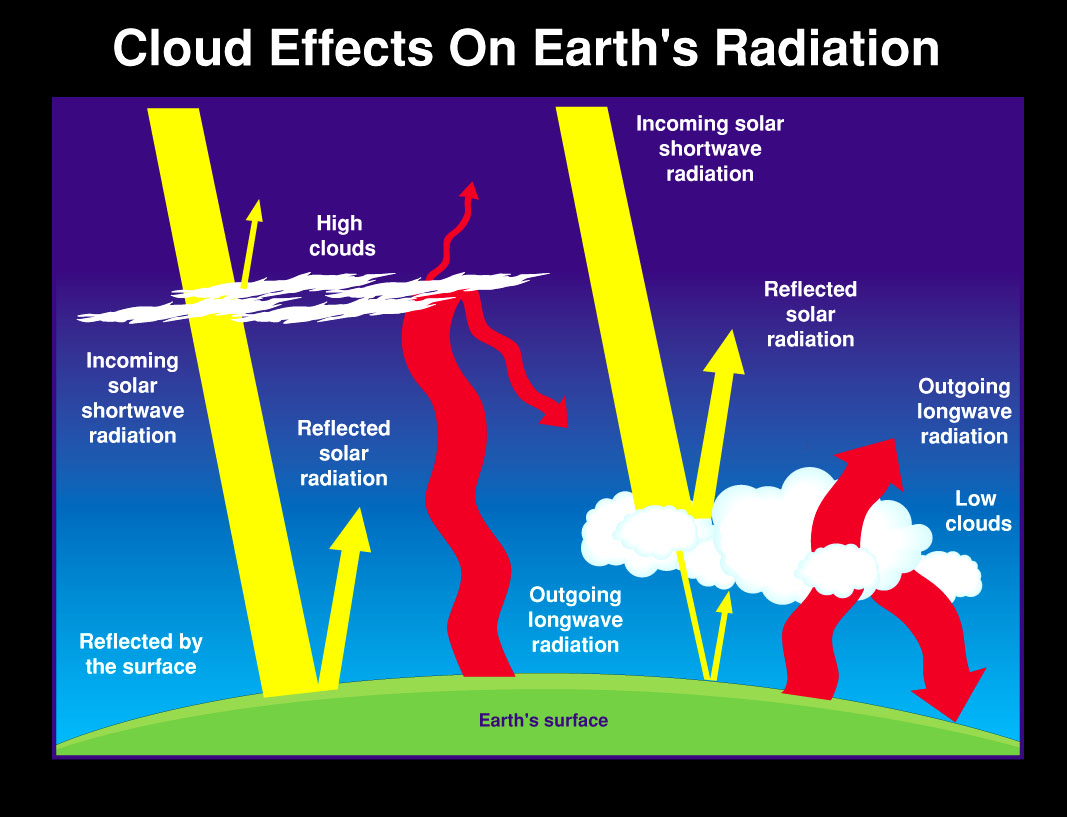 |
Most experts lean toward #2, but it is a very complex
problem and there is considerable disagreement. For example, increased temperatures will increase the evaporation of ocean water and hence may increase cloud cover, and clouds can have a large influence on greenhouse trends:(From Science@NASA, http://science.nasa.gov/headlines/y2002/22apr_ceres.htm?list749499) |
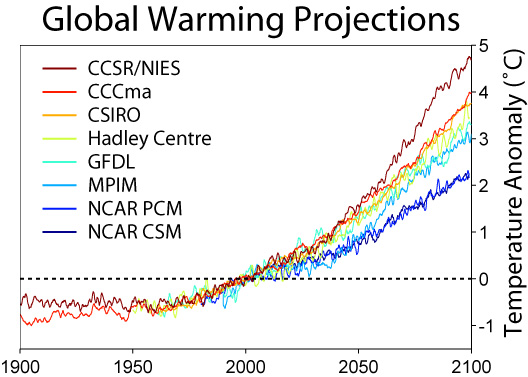 |
The net result from these possible counteracting trends is currently beyond our
ability to predict accurately
|
For more, see http://earthguide.ucsd.edu/earthguide/diagrams/greenhouse/
In any case, we have to be careful not to blame everything about the climate on human-caused greenhouse gases. There are many other factors that are also involved, but it seems very likely that we are having an impact (at the 1o C level so far and probably by 2o - 5o C by the end of this century). This information at least provides some foundation for the political discussion of what we should (and can) do about it.
 Odin, associated with
Mercury in Northern Europe, http://www.pitt.edu/~dash/odin.html Odin, associated with
Mercury in Northern Europe, http://www.pitt.edu/~dash/odin.html |

Horus, Egyptian god of Mars, http://grenier2clio.free.fr/egypte/horus.htm |
|
Click to return to syllabus |
||
| Click to return to Mercury | hypertext |
Click to go to Mars |